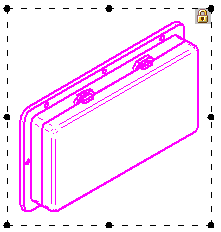Sets options for a drawing view. This command bar is displayed after a drawing view border is selected. Not all options are available for all drawing views.
Drawing View Style
Displays the name of the currently used drawing view style, or applies a different drawing view style.
Caption
Specifies the primary caption of the drawing view. Default text or property text that is displayed in this box is based on the text defined in the drawing view style for the selected drawing view type (for example, principal, section, detail). Caption text may consist of plain text, property text, and symbols.
You can add and edit multiple lines of primary caption text by typing in the box. You also can modify the content using the Caption tab (Drawing View Properties dialog box).
Show Caption
The top portion of the Select Caption list selects the caption types (primary, secondary) to be displayed for the currently selected drawing view or view annotation.
The bottom portion of the Select Caption list specifies whether to display the values for property text codes (%AS, %VS, %VR, and %LN).
Show Primary Caption
Specifies that the content defined for the Primary caption is displayed.
You can modify the caption content for the selected drawing view using the Caption tab (Drawing View Properties dialog box).
Show Secondary Caption
Specifies that the content defined for the Secondary caption is displayed. The secondary caption text always appears below the primary caption text.
You can create and modify the secondary caption content for the selected drawing view using the Caption tab (Drawing View Properties dialog box).
Note:
Even when the Show Primary Caption or Show Secondary Caption option is checked, when any of the following property text codes are part of the caption, you must also select the matching property from the Show Caption list to show its value in the caption.
Show Suffix
When a section view, detail view, or auxiliary view is selected, and when %AS is defined in the caption, displays the caption suffix.
Show Annotation Sheet Number
When a section view, detail view, or auxiliary view is selected, and when %LN is defined in the caption, displays the sheet number where the view annotation--the cutting plane, viewing plane, or detail envelope--is located.
Show View Scale
Displays the view scale in the caption when %VS is defined in the caption text.
Show Angle of Rotation
Displays the view rotation angle in the caption when %VR is added to the caption text.
Note:
Primary captions, secondary captions, and view annotation captions can be defined globally in the Drawing View style. To learn how, see these Help topics.
You also can add a primary caption to a selected drawing view using the Caption box on the Drawing View Selection command bar.
Scale
Specifies the drawing scale as a standard ratio. The specified ratio defines the size of the drawing in relation to the size of the real-world object. For a 2:1 ratio, the 2 represents the size of the drawing and the 1 represents the size of the real-world object.
Scale Value
Specifies a custom scale value.
Show Annotation
Specifies whether to display the view annotation graphics, such as the cutting plane, detail envelope, or viewing plane. Also specifies whether to display the profiles for a broken-out section view for the selected drawing view. Displaying the profiles allows you to edit the profile for a broken-out section view.
This option is available only when the selected view is the source view where the view annotation graphics are drawn.
Properties
Displays the Drawing View Properties dialog box.
Modify Drawing View Boundary
While you can modify the size of a rectangular drawing view cropping boundary simply by dragging its handles, the Modify Drawing View Boundary option allows you to define a custom, non-rectangular drawing view cropping boundary. This option is not available for dependent and independent detail views.
When you select this option, the drawing view is displayed in a special cropping window. The rectangular boundary is converted to four endpoint connected line segments. You can use the 2D drawing tools to redraw the view cropping border. However, the new cropping boundary profile must be closed.
To use a portion of the rectangular boundary window in the custom profile, draw new line segments that connect to the existing line segments. When you're done drawing the boundary, use the Trim command to remove the unneeded line segments.
To draw a new boundary profile from scratch, delete all the existing line segments and then draw the new boundary using the 2D drawing tools.
Use the Close Cropping Boundary button on the ribbon to exit the cropping window, update the view, and return to the drawing.
Click here to see illustrations showing how the Modify Drawing View Boundary option can be used to create a custom cropped drawing view.
You can return a cropped drawing view to its original display using the Uncrop command on the selected drawing view's shortcut menu.
Shading Options
Specifies color, grayscale, shading, and edge visibility for the drawing view.
Not Shaded
Displays color with visible and hidden edges, but no shading.
Shaded
Displays color and shading, but no edges.
Shaded with Edges
Displays color and shading with visible edges.
Grayscale Shaded
Displays grayscale and shading, but no edges.
Grayscale Shaded with Edges
Displays grayscale with visible edges.
Use Model Colors
Applies model colors to drawing view edges and hatching. A drawing view that uses model color goes out of date when the color is changed in the model.
Show Broken View
Shows or hides the broken view regions of the drawing view.
 Lock drawing view position
Lock drawing view position
Prevents the selected drawing views from being moved accidentally. When this box is checked, and the drawing view is highlighted, a lock symbol is displayed within the drawing view boundary to indicate its position is fixed.
A locked drawing view still can be moved using explicit commands. To learn more, see Drawing view manipulation.
